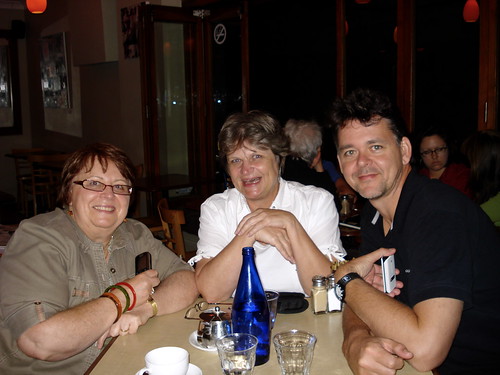 One of the really cool things about being a globally connected teacher is the opportunities to develop relationships with other like-minded educators. As I’ve said once or twice before, learning is a conversation and as we start to engage in that conversation it continues to feed our need for ongoing learning. Web 2.0 tools like Twitter and the blogosphere, as well as some still-useful “old skool” technologies like Skype, email and mobile phones means that we can be incredibly connected to each other if we choose to be.
One of the really cool things about being a globally connected teacher is the opportunities to develop relationships with other like-minded educators. As I’ve said once or twice before, learning is a conversation and as we start to engage in that conversation it continues to feed our need for ongoing learning. Web 2.0 tools like Twitter and the blogosphere, as well as some still-useful “old skool” technologies like Skype, email and mobile phones means that we can be incredibly connected to each other if we choose to be.
I started hanging around online communities a long time ago; in fact, as a teenager I was a geeky kid with a Citizens Band radio and used to sit in my room late at night having conversations with lots of people from all over Sydney and beyond that I mostly never met. (I say “mostly”, because I did actually meet a few of my CB buddies and became quite good long-term friends with some of them) When I got into computers I remember the excitement of logging onto the old fashioned BBSes (bulletin boards systems) and posting disembodied text threads back and forward with other users… the technology was the exciting part and it was easy to overlook the fact that these invisible “users” were real people just like me. Ah, good times.
As online communities started springing up all over the place in the mid 90s, I joined lots of them. Forums, discussion boards, IRC chat and IM… what these tools have always facilitated is conversation, which is critical to feeling connected and engaging with ideas. Occasionally, I have had the opportunity to connect with people from these lists IRL (in real life). I remember the first time I ever met someone IRL from the OzTeachers list… I was going to Canberra on a business trip and since I had engaged in many interesting exchanges with a Canberra based teacher-librarian called Barbara Braxton, I emailed her offlist to suggest that I drop in and have a look around her school. It’s a really nice experience to meet someone IRL whom you have only ever known virtually, and Barbara spent a good hour or so giving me a grand tour around her school.
Not long after that I had to go to Perth to run some workshops so I contacted another OzTeacher from Fremantle, Bryn Jones. I met Bryn at his place and then he and I went for a few beers down on the Freo docks and shared a few stories and ideas about education and life in general. Since then, I’ve met a number of other people from the OzTeachers list, including Adrian Greig, Fiona Banjer, Kerry Smith, Mal Lee, John Pearce and others. While being a member of an online community is a great thing, being able to put a face to the name and get to know someone in real life adds a wonderful extra dimension.
A few days ago I noticed on Twitter that Barbara Dieu from Brasil was visiting Sydney. I tweeted a quick G’day and said that maybe we should get together. Barbara thought it a good idea, so I tried to round up a few other Sydney bloggers to join us. In the end, it just ended up being the infamous Judy O’Connell from the heyjude blog, so the other night Judy, Barbara and I met up for dinner at a little café in Newtown. (The same café where Judy, Westley Fields and others had dinner with Alan Levine on his recent trip to Sydney) It was really neat to meet IRL like this… I’d met Judy briefly at a conference a few months prior, and Barbara and I had exchanged a few emails when we almost presented a session together with Sheryl Nussbaum-Beach at the Learning 2.0 conference in Shanghai last year, but to actually get together for a drink, dinner and some great stories just adds a very special dimension to the online relationships that Web 2.0 enables. (Even as I wrote that last sentence, it really hit me just how amazing these connections are and how much connectivity comes out of what seem to be fairly tenuous links… I guess that’s the strength of weak ties.)
As we sat chatting we marveled at the ease with which tools like Twitter and Skype enabled us to make connections and then organise and coordinate an event like this, but the real lesson that I took from the experience was to remind myself that these networks we create are NOT about computers and technology, they are about PEOPLE. Especially for those others who just look on at what we do, who see us spending lots of time in front of a computer, it very easy to overlook the fact that we are not spending all this time just tapping on a keyboard and interacting with bits and bytes, chips and circuits… we are interacting with real, flesh-and-blood, honest-to-goodness people.
Of course, if any of you are ever in Sydney then we should meet up. I know this great little café in Newtown…
